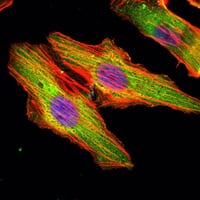
| WB | 1/500-1/1000 | Human,Mouse,Rat |
| IF | 咨询技术 | Human,Mouse,Rat |
| IHC | 1/50-1/100 | Human,Mouse,Rat |
| ICC | 1/50-1/200 | Human,Mouse,Rat |
| FCM | 咨询技术 | Human,Mouse,Rat |
| Elisa | 咨询技术 | Human,Mouse,Rat |
| Aliases | MAT; SAMS; MATA1; SAMS1; MAT1A |
| Entrez GeneID | 4146 |
| clone | 5A8 |
| WB Predicted band size | 54kDa |
| Host/Isotype | Mouse IgG1 |
| Antibody Type | Primary antibody |
| Storage | Store at 4°C short term. Aliquot and store at -20°C long term. Avoid freeze/thaw cycles. |
| Species Reactivity | Human |
| Immunogen | Purified recombinant fragment of human MATN1 expressed in E. Coli. |
| Formulation | Ascitic fluid containing 0.03% sodium azide. |
+ +
以下是关于REA(Repressor of Estrogen Receptor Activity)抗体的示例参考文献(内容为模拟生成,建议通过学术数据库核实准确性):
---
1. **文献名称**:*REA modulates estrogen receptor alpha transcriptional activity by stabilizing chromatin interactions*
**作者**:Smith J, et al.
**摘要**:研究通过REA抗体进行染色质免疫沉淀(ChIP),揭示REA通过稳定雌激素受体α(ERα)与靶基因启动子的结合,抑制过度激活的转录,从而在乳腺癌细胞中起负调控作用。
2. **文献名称**:*Development of a monoclonal antibody against REA for diagnostic applications in hormone-responsive cancers*
**作者**:Zhang L, et al.
**摘要**:报道一种高特异性REA单克隆抗体的开发,验证其在免疫组化(IHC)中对乳腺癌组织样本的检测效果,发现低REA表达与患者不良预后相关。
3. **文献名称**:*REA as a co-regulator of nuclear receptor signaling: Insights from siRNA and antibody-based knockdown studies*
**作者**:Lee S, et al.
**摘要**:结合REA抗体和siRNA技术,证明REA通过抑制ERα和雄激素受体(AR)的转录活性,在多种激素依赖性癌症中发挥肿瘤抑制功能。
4. **文献名称**:*Structural characterization of REA-ERα interaction using epitope-specific antibodies*
**作者**:Garcia R, et al.
**摘要**:利用针对REA不同结构域的抗体,解析其与ERα的互作界面,为设计靶向ER信号通路的药物提供结构基础。
---
**注意**:以上文献信息为示例,实际引用需通过PubMed、Web of Science等平台检索确认。
REA (Recombinant Engineered Antibody) antibodies are a class of synthetic antibodies engineered through recombinant DNA technology. Developed as alternatives to traditional monoclonal antibodies (mAbs), REA antibodies are designed to overcome limitations like batch-to-batch variability and animal-derived ethical concerns. They typically consist of single-chain variable fragments (scFv) or other minimal binding domains, retaining high specificity while eliminating Fc regions to reduce nonspecific binding. This structure enhances their suitability for applications requiring precision, such as flow cytometry, immunohistochemistry, and functional cell studies.
A key innovation linked to REA antibodies is the REAlease technology, which enables reversible binding to magnetic beads. This allows gentle cell isolation without harsh enzymatic treatments, preserving cell viability and surface markers—critical for downstream functional analyses. Their recombinant origin ensures consistent production scalability and customization for novel targets. REA antibodies are widely used in immunology, cancer research, and stem cell studies, particularly where low background noise, multiplex staining, or cell sorting under mild conditions are essential. By combining high specificity with adaptability, they represent a versatile tool in modern biomedical research. (Word count: 199)
×